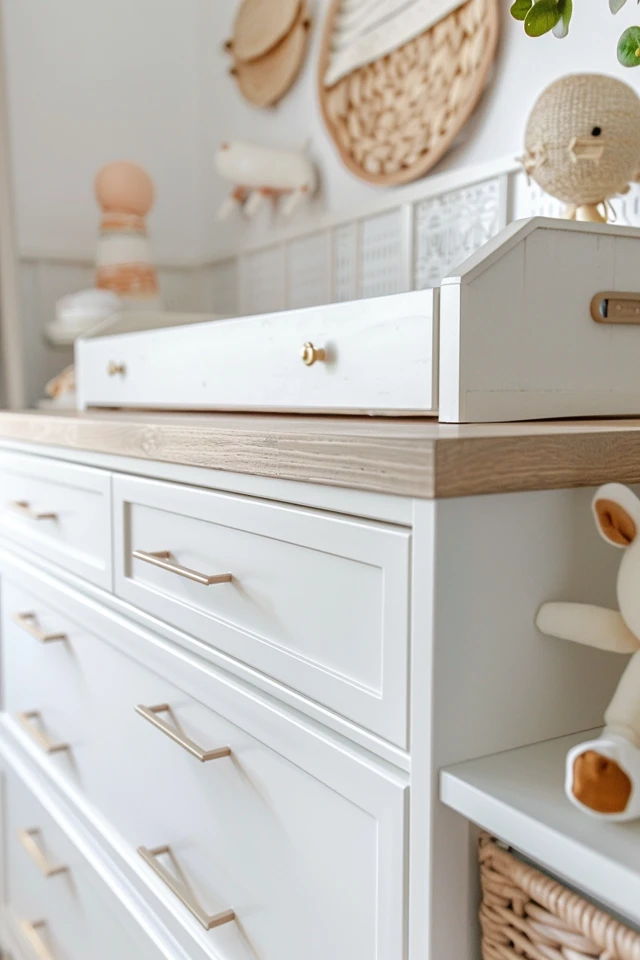Hello, fellow parents! As a parent, I understand the struggle of keeping a baby dresser organized and functional. With all the adorable tiny clothes, diapers, wipes, and various baby essentials, it’s easy for things to get messy and overwhelming. But fear not! In this article, I will share some organizing tips and efficient storage solutions to help you transform your baby dresser into a tidy and well-structured space.
First things first, it’s essential to “live” with the space before determining the best storage system for your baby dresser. Take note of the items you frequently use and those that are rarely touched. This will give you a better idea of how to allocate space efficiently.
Hanging as much as possible in the closet is a great way to maximize the space in your baby dresser. Assign specific drawers for different categories of items, such as socks and hats, diapers and wipes, and pants and shorts. This will not only make it easier for you to find what you need quickly but also maintain an organized structure for the long haul.

Utilize expandable drawer dividers to keep similar items together and prevent them from getting mixed up. Your baby’s tiny socks and burp cloths will no longer mysteriously disappear!
For optimal convenience, use the top drawer of your baby dresser for frequently used items like socks, hats, and burp cloths. Reserve the second drawer for diapers, wipes, creams, and grooming essentials.
When it comes to storing baby clothes, it’s crucial to assess and sort them by size and type. Folding or rolling clothes can save space and allow you to see everything at a glance. Plan the layout of your dresser to determine where each category of items will be stored.
Lastly, establishing a routine to regularly declutter and maintain the organization of your baby dresser is essential. It will help you keep everything in order and prevent unnecessary clutter from accumulating.
Key Takeaways:
- Hang as much as possible in the closet to save space in the baby dresser.
- Assign specific drawers for different categories of items for easy access.
- Utilize expandable drawer dividers to keep similar items together and maintain an organized structure.
- Use the top drawer for frequently used items and reserve the second drawer for diapers and grooming essentials.
- Assess and sort baby clothes by size and type to optimize space.

Creating a Functional Changing Station
When it comes to changing diapers, having a functional and well-organized changing station can make all the difference. Here are some tips to help you create a convenient and efficient diaper changing area:
Invest in a sturdy and spacious dresser that can double as a changing station. This will provide ample storage space for all your diaper changing essentials.
Arrange the top of the dresser with a soft and comfortable changing pad. This will create a dedicated space for diaper changes and ensure your baby’s comfort.
Keep your diaper changing essentials within arm’s reach by organizing them in a diaper caddy. This will help you stay organized and have everything you need at your fingertips.
Utilize the top drawers of the dresser to store frequently accessed diaper changing essentials such as diapers, wipes, creams, and grooming supplies.
For easy access and organization of wipes, place a wipe dispenser next to the changing pad. This will save you time and ensure that wipes are always within reach.
Label drawers and dividers to create a designated spot for each item in your changing station. This will help you stay organized and quickly find what you need.
Make the most of your nursery closet by using it to store special occasion outfits and seasonal clothes. This will free up space in the dresser for everyday clothing and essentials.
Add decorative storage baskets and bar carts to your changing station area. These can be used to store overflow items and keep your changing station clutter-free.
Keep pacifiers on display in a clear jar or catchall for easy access. This will ensure that you always have a pacifier within reach during diaper changes.
Regularly rotate seasonal clothes in your nursery closet and declutter items that your baby has outgrown. This will help you maintain an organized and efficient changing station.
Establish a routine for folding and returning clothes to their designated spots after each use. This will ensure that your changing station remains tidy and ready for the next diaper change.
By following these tips and creating a functional changing station, you can streamline your diaper changing routine and make it a more enjoyable experience for both you and your baby.

Conclusion
Organizing a baby dresser is crucial for optimizing space and maintaining an organized nursery. By categorizing items and using drawer dividers, you can easily keep like items together and accessible. Consider using the file folding method to store baby clothes, allowing you to see everything at a glance and maximize space in the dresser.
Creating a functional changing station is also essential. Include a diaper caddy and wipe dispenser to streamline diaper changes, keeping everything within reach. Don’t forget to label drawers and dividers to ensure every item has a designated spot.
Remember to utilize the nursery closet for storing special outfits and seasonal clothes, keeping the dresser clutter-free. Establishing a routine for decluttering and maintaining organization will help you to keep an organized nursery. Additionally, decorative storage baskets and bar carts can optimize space while providing creative storage solutions.
In conclusion, organizing a baby dresser efficiently is key to maintaining a tidy and functional nursery. By implementing these nursery dresser organization ideas and optimizing space, you can create a well-organized and welcoming space for both baby and parent.

